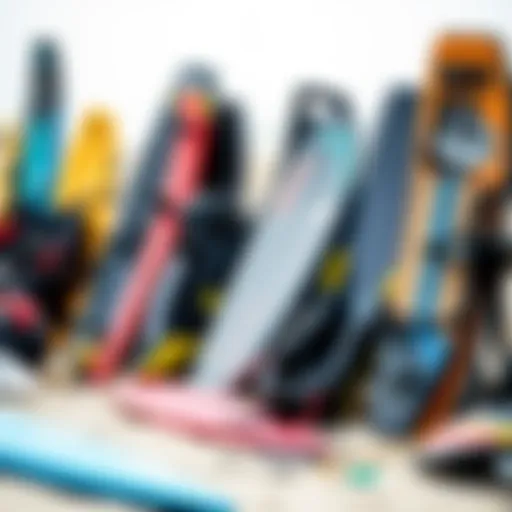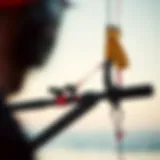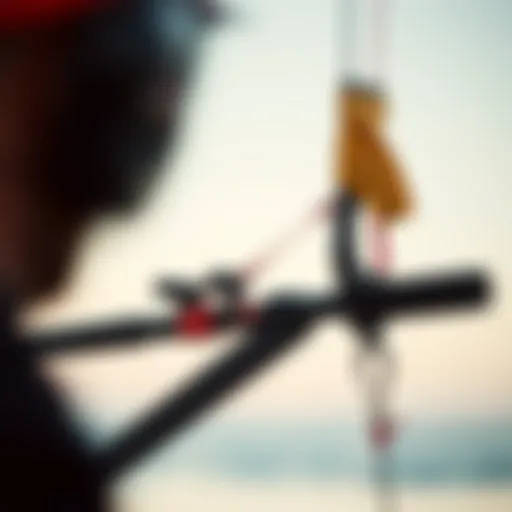Optimal Choices in Kiteboarding Training Kites
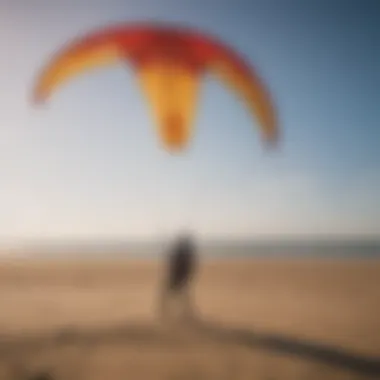

Intro
Kiteboarding, an exhilarating fusion of wind, water, and skill, is not just about adrenaline; it’s also a delightful dance of choices. Among these choices, the selection of the right training kites stands as a crucial factor for anyone aspiring to glide seamlessly over waves or master the skies. Hence, embarking on this journey requires a solid understanding of what training kites entail and how they can elevate one's kiteboarding game.
In this comprehensive guide, we will explore various training kites available and their significance in skill development for beginners and intermediates. Whether you are just starting, looking to brush up skills, or curious about the seasonal gear changes, we’ll lay out the groundwork to help you navigate this vibrant niche of kiteboarding.
Training kites offer a unique blend of control and performance, tailored to meet the specific needs of different users. Factors such as wind conditions, skill levels, and personal goals weigh heavily when selecting the ideal kite. Moreover, misconceptions surrounding training kites often cloud judgment, making it essential to clarify these points and equip you with the right knowledge before taking that leap into kiteboarding.
So, let’s dive in, starting with Gear Selection, ensuring you have the right setup that suits your journey in this magnificent sport.
Understanding Training Kites
The realm of kiteboarding is as vast as the ocean itself. Within this sphere, training kites play a crucial role in shaping a kiteboarder’s journey. It’s not just about grabbing a kite and hitting the waves; understanding training kites lays the groundwork for a fruitful learning experience. Having a solid grasp of what training kites are and their purpose will help beginners avoid tricky pitfalls and optimize their skill development.
Definition and Purpose
Training kites are essentially tools designed to help individuals learn the basics of kiteboarding. Their primary function is to provide an opportunity for practice in controlled conditions, allowing users to develop their skills before transitioning to larger, more powerful kites.
In simpler terms, think of them as the training wheels of kiteboarding. Just as kids might use training wheels to get the hang of balancing on a bicycle, training kites enable beginners to understand wind dynamics, power control, and maneuvering—all essential skills for successful kiteboarding. These kites are generally lighter and more forgiving, making them perfect for those stepping into the kiteboarding world for the first time.
Role in Skill Development
When it comes to learning kiteboarding, repetition and familiarity are key. Training kites facilitate an environment where learners can practice without the overwhelming power of more advanced kites. They allow budding kiteboarders to gradually build confidence and proficiency.
In practical terms, using a training kite can help hone the following skills:
- Understanding Wind Patterns: Learning how to read the wind is crucial. Training kites assist in developing a feel for how kite position affects lift and direction.
- Body Coordination: The physicality of kiteboarding requires finesse. Training kites aid in refining motor skills, making it easier to control movements when the rider finally tackles larger kites.
- Safety Awareness: Training with a smaller kite allows users to focus on safety without the looming concern of overpowering winds. New users learn the risks involved, and how to mitigate them, before stepping into advanced training.
Developing proficiency with a training kite sets the stage for greater achievements in kiteboarding. The investment in time and practice pays off when riders progress to high-performance kites confidently.
Types of Training Kites
Understanding the different types of training kites is crucial for anyone venturing into the world of kiteboarding. Each type serves distinct purposes and brings unique advantages to the table. By familiarizing oneself with these options, aspiring kiteboarders can make better choices tailored to their individual skill levels and training needs.
Foil Kites
Foil kites are among the most popular choices for beginners and seasoned kiteboarders alike. Made up of cells that inflate with air, they create a solid structure that's lightweight yet powerful. One of the significant benefits of foil kites is their efficiency in a broader wind range. This means you can fly them even in lighter winds, making them versatile across different conditions.
These kites generally feature a simpler design, with no need for an external pump, which adds to their convenience. However, controlling foil kites can be tricky due to their lack of rigid frame; they require a good understanding of airflow and control techniques. Thus, they are suited for those who are not only starting out but also those aiming to refine their skills.
Leading Edge Inflatable Kites
On the other hand, leading edge inflatable kites, also known as LEIs, have become a staple in the kiteboarding community. Recognized for their robust design, LEIs are primarily built with inflatable chambers that keep the kite stable in mid-air. This stability is particularly beneficial when tackling gusty winds, offering a consistent flying experience.
The ease of launching and landing LEIs makes them ideal for learning. However, these kites are often favored by advanced riders as well, mainly due to their ability to generate substantial power and lift. A downside, though, is that they require a pump for inflation, which could put off some beginners. But considering the advantages in performance and ease of handling once you get the hang of it, LEIs are well worth it.
Single-Line vs. Multi-Line Kites
When it comes to control mechanisms, the choice between single-line and multi-line kites is fundamental. Single-line kites, as the name suggests, use only one line for control, making them straightforward and user-friendly. They're excellent for very young kids or those who are just beginning their journey, as they require minimal skill to fly.
Multi-line kites, however, are the choice for those looking to expand their skill set. These kites typically have two to five lines, allowing for more precise control over the kite's movement. This enables riders to maneuver effortlessly and perform tricks as they progress. The enhanced control comes with its own set of challenges, as the learning curve is steeper compared to single-line options.
Ultimately, selecting between single-line and multi-line kites boils down to your aspirations in kiteboarding. If your goal is to build a solid foundation and enjoy light flying, single-line kites might serve you well. But, if you aim to dive deeper into the sport, multi-line kites can elevate your experience significantly, offering a path toward more dynamic maneuvers.
"Selecting the right type of kite is like picking the right tool for a job; it can make all the difference in your performance and growth as a rider."
Understanding these types of training kites not only enhances your kiteboarding journey but also paves the way for a more enjoyable, effective, and safe learning process.
Key Features to Consider
When diving into the world of training kites for kiteboarding, it’s crucial to consider several key features that can significantly influence your experience on the water. This section lays out the fundamental elements that must be taken into account before making a selection. By understanding these features, you can avoid the pitfalls that come from choosing a kite that doesn’t suit your needs, ensuring that your training is both effective and enjoyable.
Size and Wind Range
The size of a training kite plays a pivotal role in how it performs under different wind conditions. Generally, kites are labeled by their surface area measured in square meters. For instance, a larger kite provides more power and lift, which could be beneficial for someone looking to practice advanced maneuvers. However, there’s a trade-off.
- Wind Range: Each kite is designed to perform optimally within a specific wind range. A smaller kite might be ideal for light winds, making it easier for beginners to manage the kite’s power and stability. Conversely, if the wind is stronger, a larger kite becomes the go-to choice. It’s like choosing the right tool for the job; using a sledgehammer when you need a scalpel won’t end well.
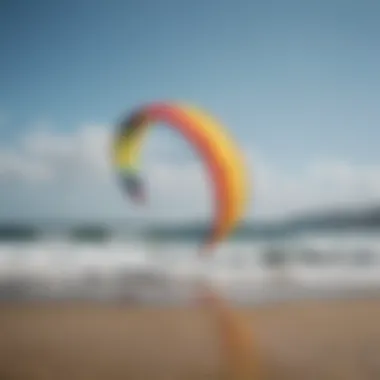

In short, knowing your local conditions and matching them with the kite’s specifications is essential. Beginners should lean towards kites that can handle a broader wind range, while more advanced riders can opt for specific sizes based on the wind forecast.
Material and Durability
The material used to construct the training kite greatly affects its performance and lifespan. Most kites are made of ripstop nylon or polyester, which are both lightweight and strong.
- Durability: A kite that is built with lower-quality materials might save you some bucks but will likely fall apart after a few sessions, leaving you with the wind in your sails but no kite to fly. Look for kites made with reinforced seams and UV-resistant materials; this ensures they can withstand harsh conditions and give you longevity over time. Proper maintenance can also boost durability.
Selections vary widely, and it is advisable to evaluate a kite's material before purchasing. If you’re one to fly in rough conditions or near rocky shores, choosing a more durable kite is non-negotiable.
Control Systems
When it comes to controlling your kite, the system you choose can dramatically affect your overall experience. Control systems vary but typically include the following components: control lines, safety systems, and the bar.
- Ease of Use: A well-designed control system makes flying a kite intuitive. Many modern training kites come equipped with features that allow for quick release and secure attachment, which can be a lifesaver in emergency situations. If the control lines are tangled or the safety features are cumbersome, it can lead to frustrating lessons and even accidents.
- Adjustability: Some control systems allow you to adjust the length of the lines, which can help tailor the kite's behavior to your skill level. This is particularly useful as you progress; it can feel like having a trusted friend helping you learn.
- Feedback: When flying a kite, getting the right feedback through the bar is essential for understanding what your kite is doing in the air. Look for systems that provide clear responses without unnecessary resistance. This responsive connection allows you to learn faster and build that essential muscle memory.
Investing time to understand these features and how they complement each other will ensure you make a well-informed decision that enriches your kiteboarding journey. Each feature contributes not only to your safety but also to your overall enjoyment and skill enhancement in kiteboarding.
"Choosing the right training kite is like picking the right dance partner; the better the match, the smoother the moves."
Selecting the Right Training Kite
Choosing the ideal training kite is no small feat. This decision can significantly shape a rider's journey, whether they're just starting to dip their toes or have a few sessions under their belts. Getting this choice right can pave the way for mastering skills and enjoying the winds to the fullest.
When pondering over which kite to grab, several factors come into play. You must weigh them carefully, as each can make the difference between soaring high and facing challenges that may stunt progress.
Assessing Skill Level
Understanding your skill level is a foundational step in selecting the right training kite. For beginners, a larger kite is typically recommended as it catches more wind, making it easier to stay in the air while learning basic skills. However, an oversized kite can be unmanageable, especially in stronger winds. Newbies should opt for kites that provide stability and predictable handling so they can build comfort without feeling overwhelmed.
On the other hand, more experienced riders might want a kite that allows for challenging maneuvers and increased responsiveness. These riders often benefit from choosing options that match their ambition and skill set. Tailoring your selection based on your growth as a kiteboarder is essential. It’s a common misstep to go too big (or too small) based solely on enthusiasm rather than ability.
Environment Considerations
Your kite's performance hinges significantly on the environment in which you plan to ride. As much as personal preference plays a role, understanding local wind patterns and conditions is crucial.
For instance, if your training grounds are often gusty, a more robust and stable kite cushion allows for safer handling. Conversely, if you're in consistently light winds, a larger surface area kite can help you maintain flight without trouble.
Other aspects to consider include the terrain. Are you mostly on flat water or in choppy, wave conditions? Remember that kites designed for specific environments may perform poorly in others. So, check your spots, study the conditions, and keep your kite needs specific to that.
Budget Considerations
Lastly, but certainly not least, is the budget consideration. Kiteboarding can become an expensive hobby, and training kites are no exception. While it's tempting to splurge on the latest and greatest model, there are solid options available at various price points.
Here are a few tips to manage your investment wisely:
- Quality vs. Price: A higher price doesn’t always guarantee superior performance. Often, mid-range kites offer fantastic durability and functionality without making your wallet weep.
- Second-Hand Deals: Don’t overlook the second-hand market. Well-cared-for kites can be a goldmine for a budget-conscious rider, provided you check their condition thoroughly.
- Long-Term Investment: Think about what you plan for your kiteboarding journey. If you’re serious, spending a bit more upfront on a good-quality kite could save you money on replacements down the road.
"Investing wisely today means less stress tomorrow."
Selecting the right training kite involves a mix of personal preferences, skill assessment, environmental awareness, and financial planning. By weighing these elements carefully, you can find a kite that not only fits today’s needs but also grows with you into tomorrow's adventures.
Techniques for Effective Training
In kiteboarding, mastering the kite is just half the battle. The other half lies in effectively employing techniques that will enhance your skill set and maximize your safety. These techniques not only boost confidence for beginners but also help seasoned riders refine their abilities. Proper stance, power control, and the ability to generate lift are crucial in making the kite work for you, rather than against you. Getting these elements right ensures a smoother ride and a better understanding of the dynamics of the sport.
Stance and Positioning
The first step to becoming a proficient kiteboarder is understanding your stance. Your body position can make or break your experience on the water. A solid base provides balance and stability, which is vital when you’re out there trying to control a rather large piece of fabric caught in the wind.
When standing, feet shoulder-width apart offers the right amount of leverage. Bend your knees slightly and keep your body relaxed. Think of it like standing against a strong gust; your knees act like shock absorbers. This stance allows you to shift your weight quickly:
- Lean slightly back to keep the kite stable in high winds.
- When attempting turns or jumps, shifting your weight to the front foot is key.
- Keep your core engaged; it aids in maintaining balance and helps with movement.
Furthermore, hand positioning on the control bar is equally important. Your front hand should guide the kite while the back hand provides the necessary control. Think of it as a seesaw; if one side is too heavy or too light, the whole system can tip over. Find that balance between both hands to steer effectively without overcorrecting.
Power Control
Power control in kiteboarding isn’t merely about pulling harder on the bar. It’s akin to playing a musical instrument; one must learn to play softly and loudly at the right moments. The ability to manage the kite’s power directly impacts your comfort and maneuverability.


A few things to keep in mind:
- Understand the wind window: This is the area in which the kite generates power. Keeping the kite at 12 o'clock means minimal pull, while having it low creates maximum power. Learning to navigate the wind window will help you harness or reduce power as needed.
- Feathering: Instead of yanking the control bar, gently pulling in or letting out the line offers better control over the kite’s power. This approach allows greater finesse, especially when performing tricky maneuvers.
- Look for wind shifts: Conditions can change unexpectedly. Keeping an eye out for shifts enables you to adapt accordingly. If the wind strengthens, lower the kite’s position in the window. Conversely, if it’s dying down, raise it to catch more lift.
Mastering power control means riding with confidence rather than fighting against the wind. It allows you to take full advantage of the kite’s capabilities without exhausting yourself in the process.
Generating Lift
Generating lift is a key feature in kiteboarding. Without it, you’ll find yourself stuck looking up at the sky rather than slicing through waves or catching air.
To effectively generate lift, consider the following techniques:
- Timing with the kite: As the kite comes overhead, fundamental timing plays a role. Pulling on the control bar at the right moment—when the kite is riding high—can create lift. A synchronized motion between body and kite will enhance uplift when you leap off the water.
- Adjusting your body position: Leaning back while jumping can help load tension on the lines, giving the lift a good push. Moreover, staying compact while in the air optimizes your aerodynamic shape, allowing for an easier descent.
- Utilizing the wind: Utilize the wind's power and your body positioning to maximize lift. Approach a swell at a slight angle to harness the upward force created as the kite flies through the air.
All these elements feed into a single yet impactful outcome: developing a strong sense of how to manipulate the kite in various conditions. This understanding can elevate a kiteboarding experience to new heights.
"Adapting to circumstances and mastering techniques allows kiteboarders to turn challenging winds into exhilarating rides."
By grasping these techniques and practicing diligently, a kiteboarder can progress rapidly, elevating not just their skills but also their enjoyment on the water.
Safety Considerations in Kiteboarding
In kiteboarding, where wind and waves play the lead roles, safety becomes paramount. Choosing the right kite and understanding how these factors influence your experience goes hand in hand with ensuring that you remain safe while enjoying this exhilarating sport. No matter your skill level, precautions must be taken to minimize risks and enhance enjoyment. This section dives into the fundamentals of kiteboarding safety, empowering you to be both informed and prepared.
Pre-Flight Checklist
A thorough pre-flight checklist is one of those golden rules that kiteboarders can’t afford to overlook. Just like a pilot reviews their flight plan, you must check several elements before launching your kite. Here’s a breakdown of some must-do tasks:
- Inspect your kite and lines: Look for any wear and tear, particularly on the leading edge and the canopy. Are the lines tangled or frayed? A minute now can save a catastrophe later.
- Check your control bar: Ensure your lines are properly aligned and that the release safety mechanism is functioning. This is a safety feature that must be in tip-top shape.
- Assess wind conditions: Understanding the wind speed and gusts can tell you if it is too dangerous to fly your kite. Winds that are inconsistent can turn a good day into a bad experience.
- Local rules and regulations: Some beaches have specific guidelines to follow. Be aware of any restrictions in place.
Be diligent and thorough—your safety might just hinge on that extra check.
Understanding Wind Directions
A genuine understanding of the wind can feel like trying to read a foreign language, but grasping the basics can be a real game changer. Here’s the straightforward scoop on wind directions:
- Onshore Winds: Ideal for beginners as they blow from the land toward the sea. This offers a natural buffer should mishaps occur.
- Offshore Winds: While exciting, this wind condition often poses higher risks because they blow from the sea to the shore, taking you further away from safety if something goes awry.
- Cross-shore Winds: These winds can be effective for experienced kiteboarders but can also create challenges when trying to control your kite.
If you know how to assess wind directions, you’ll better anticipate safety concerns and improve your overall riding experience.
Emergency Procedures
Kiteboarding is exhilarating, but surprises can pop up. Having a plan is akin to holding fire insurance—something you hope to never need but are grateful to have in moments of crisis.
- Quick Release Mechanism: Always familiarize yourself with the quick release system on your control bar. This feature is usually your go-to if things get tangled up.
- Signal for Help: Know how to attract attention if needed. Whether flailing your arms or signaling with a whistle, be prepared to communicate distress.
- Safe Landing: Practice controlled landings. Catching your kite with the lines can minimize the risks of it taking off uncontrolled.
In emergencies, every second can count. Understanding these procedures might just mean the difference between a fun adventure and a nasty incident.
"Safety is not just a priority; it is a practice that can save lives and ensure enjoyment during kiteboarding."
Common Misconceptions about Training Kites
Understanding the common misconceptions surrounding training kites is crucial for anyone involved in kiteboarding. These misunderstandings can lead to poor choices that may hinder learning and progress. It's not enough to know the ropes; it’s also vital to grasp what should not be taken at face value. Misbeliefs about size, power, and overall performance can cloud judgment, causing frustration for beginners and even seasoned riders.
One of the core aims of this section is to pinpoint and address misbeliefs that could prevent kiteboarders from selecting appropriate training kites. By demystifying these aspects, we give riders the confidence to make informed decisions. Explaining the nuances of size and power, along with setting realistic performance expectations, can significantly enhance the training experience.
Beliefs on Size and Power
A common thought among novices is that bigger kites automatically equate to more power. This is a simplistic view and often leads to trouble on the water. For instance, while larger training kites do generate increased power, they also require greater skill to handle effectively. A large kite can be overwhelming, especially in gusty conditions or for those still mastering their balance.
- Sizing Is Contextual: The size of the kite should reflect not just personal preference but also wind conditions. A bigger kite in lighter winds might seem like a great idea, but it can easily overpower a new rider.
- Power vs. Control: Smaller kites tend to provide better control, allowing learners to focus on fundamental skills without getting swept away by excessive lift and speed.
- The Sweet Spot: Typically, a medium-sized training kite strikes a balance between power and manageability. Riders can learn the ropes with consistent feedback without the constant struggle against the kite.
For example, a beginner might assume a 12-meter kite is ideal for all conditions. Yet, when waves become choppy or wind speed fluctuates, that same kite could turn from a friend into a foe. Choosing the right size means understanding how it will perform in various scenarios—knowledge that comes with experience.
Performance Expectations
Every kiteboarder walks onto the beach with dreams of gliding with grace, but misconceptions about kites can set unrealistic performance expectations. Many beleive that having the fanciest kite will instantly elevate their skill level, leading to disappointment.
- Practice Over Equipment: Performance is largely about practice and not merely the kite you possess. Technique refinement contributes more to success than any high-end kite. It's crucial to remember that equipment can support performance, but mastery comes from hours spent honing experience over flashy gear.
- Progress is Gradual: The path to improvement is a marathon, not a sprint. Riders must appreciate that skills will evolve over time. Expecting immediate results can lead to disheartenment.
- Kite Adjustments: Riders might fail to recognize that performance varies not just with the kite but with adjustments such as trim settings. Understanding how to tweak a kite can unlock its potential for better responsiveness, demanding a more hands-on approach and patience from the user.
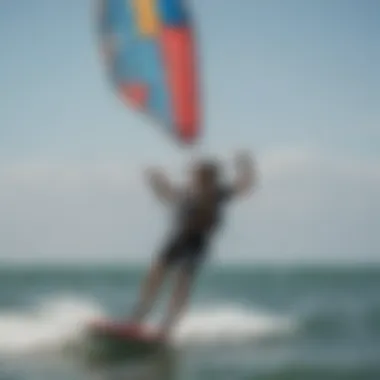

It's imperative to meet performance with an understanding that basic techniques and knowledge are the real driving forces behind flying a kite well. So, staying grounded and ensuring that both mind and skill are aligned will pave the way for smoother kiteboarding journeys.
“Remember, every expert was once a beginner. High performance starts with solid foundations.”
By addressing these misconceptions, we empower novice kiteboarders and reinforce the critical idea that the journey is as valuable as the destination.
Maintenance and Care of Training Kites
Caring for your training kite is not just a matter of keeping it clean; it’s about ensuring longevity and performance. Training kites endure a lot, from harsh winds to sandy shores. Proper maintenance minimizes the risk of accidents and enhances your overall kiteboarding experience. Without ccare, even the most expensive kite can become a liability in adverse conditions.
The benefits of maintaining your equipment are far-reaching. Regular care prolongs the lifespan of the kite, saving you from frequent replacements. Additionally, a well-maintained kite performs better, allowing for smoother flights and more effective training sessions. Also, it reduces the risk of mid-flight failures, which can be both frustrating and dangerous. This section breaks down key practices into two main parts: post-session care and best storage practices.
Post-Session Care
Taking care of your kite after each session holds utmost importance. Here are some pivotal steps to follow:
- Inspect for Damage: After every outing, take a few moments to inspect your kite for any visible tears or worn areas. Even minor issues should be addressed immediately.
- Rinse with Fresh Water: Saltwater or sand can wreak havoc on the materials. Give your kite a good rinse in freshwater to knock off any abrasive particles.
- Dry Thoroughly: Never store your kite wet. Moisture can cause mold or mildew. Hang it out to air dry completely before packing.
- Check Lines and Hardware: Ensure that the lines are untangled, straight, and free from frays. Check the connectors and hardware for any signs of wear.
Remember: A few extra minutes of care can save you headaches down the line.
Storage Best Practices
Proper storage of your training kite is just as crucial as maintenance. Here are strategies for optimal storage:
- Cool and Dry Spot: Store your kite in a cool, dry environment, away from excessive heat or direct sunlight. UV rays can degrade materials over time.
- Roll, Don't Fold: Rolling your kite instead of folding it prevents creases and creases can weaken the fabric. Use a storage bag that provides structure without cramming.
- Separate from Heavy Objects: Keep your kite away from heavy gear that could crush or damage it. Avoid stacking it under other equipment while in storage.
- Organize Your Gear: Having a designated spot for each piece of equipment makes it easier to maintain cleanliness and access items when needed.
Following these steps ensures that your training kite remains in peak condition, ready for every thrilling ride. As kiteboarding continues to evolve, conscientious maintenance practices allow enthusiasts to enjoy the sport safely and effectively.
Evolving Trends in Training Kites
The design and functionality of training kites are undergoing continuous adaptation, influenced by both technological advancements and the changing needs of kiteboarders. These evolving trends are critical as they shape how individuals train, enhancing safety and proficiency in the sport. Understanding these trends is essential not only for novice riders but also for seasoned practitioners seeking to refine their skills.
Technological Innovations
In a world that thrives on innovation, the kiteboarding industry is no exception. Recent advancements offer significant improvements to training kites, affecting everything from aerodynamics to user experience. Here are some notable tech trends:
- Smart Kites: Integrating sensors into kites has opened new doors. These sensors provide real-time feedback on performance metrics—such as lift, drag, and wind speed—enabling riders to make precise adjustments. By analyzing this data, users can learn faster and improve their flying techniques.
- Weight Reduction: Several manufacturers are now employing lighter materials without sacrificing durability. This shift allows for increased responsiveness, allowing a rider to control the kite more easily, especially during their initial learning phases.
- Enhanced Control Systems: New control systems give users better handling options. For example, some kites now come with intuitive steering mechanisms that simplify navigation for beginners. This means less struggle, and more focus on enjoying the ride.
Essentially, these innovations not only improve the overall experience but also enhance safety by making kites easier to manage. This is especially important for those in the learning stages, reducing the risk of unexpected accidents.
Sustainable Materials
As the conversation around environmental consciousness grows, many kiteboard manufacturers are responding positively by implementing sustainable practices. The use of eco-friendly materials has become a significant trend, aligning with the broader movement towards sustainability in all industries.
- Recycled Fabrics: Some kites are now made from recycled materials, such as PET (polyethylene terephthalate). This choice reduces waste and promotes a circular economy. Kiteboarders can feel good about not only enjoying the sport but also protecting the planet.
- Biodegradable Components: Innovations go further to include biodegradable additives in kite production. While traditional kites rely on materials that contribute to marine pollution, new designs incorporate elements that break down more easily, minimizing environmental impact over time.
Choosing a kite made from sustainable materials can reflect a rider's commitment to the environment, offering both a practical and ethical reason to invest in newer models.
"The blend of evolving tech and sustainability principles in kite designs ensures that both performance and environmental impacts are taken into equal account."
Understanding these trends enables kiteboarding enthusiasts to make informed decisions when selecting their training tools. Whether it's embracing the latest technology or opting for sustainable choices, recognizing the evolution in training kites can profoundly influence the overall kiteboarding experience.
The End
The conclusion serves as a pivotal component of this article, wrapping up all the facets discussed about training kites in kiteboarding. It offers a chance to reflect on the critical insights presented, ensuring that both novices and seasoned professionals understand the cumulative knowledge shared.
One crucial element here is the summarization of features and types of training kites. We discussed how different sizes, wind ranges, materials, and control systems all play a role in enhancing skill development. By revisiting these points, readers can better appreciate the nuances of selecting a training kite that aligns with their unique requirements.
Also, safety considerations cannot be overlooked. We emphasized how understanding the wind, thorough pre-flight checklists, and effective emergency procedures significantly impact one's kiteboarding experience. Summing up, it encourages a mindset grounded in safety and personal responsibility.
Factors like budget constraints and environmental considerations were covered to help form a balanced view of the investment in kiteboarding. As kiteboarding can be an expensive endeavor, the importance of thoughtful investment choices in training kites also must to be considered.
By distilling this information, the conclusion not only reinforces the understanding of each topic but also encourages kiteboarders to apply their gained knowledge in real-world scenarios, which can enhance their learning journey.
Ultimately, as kiteboarding continues to evolve with new technology and methodologies, ensuring that one is informed about the best training kites is more important than ever.
"Knowledge is the foundation of confidence; apply it wisely."
In summary, this conclusive segment highlights the key components and motivations required for making optimal choices in kiteboarding, aiding readers in navigating the exciting and challenging world of kiteboarding effectively.
Summarizing Key Points
- Understanding training kites: Recognizes the essential purpose and types of kites such as foil, and leading edge inflatable. Each has its own benefits, playing different roles in skill improvement.
- Key features: Details in size selection, wind range adaptability, material strength, and control systems, all critical in ensuring a productive training experience.
- Selection considerations: Stressing the importance of assessing personal skill levels and environment allows for a tailored approach to kiteboarding.
- Safety first: Emphasizing the necessity of safety measures, including understanding the wind conditions and emergency protocols.
- Budget considerations: Acknowledging the financial aspect reinforces the notion of strategic investments in kiteboarding gear.
This blend of insights equips readers with a comprehensive understanding of training kites, ensuring they are not just better informed, but also prepared to take action in enhancing their kiteboarding experience.











